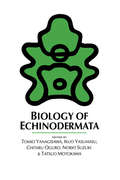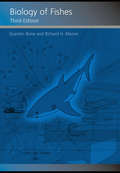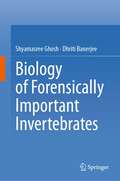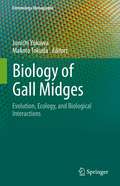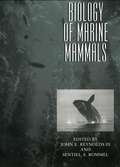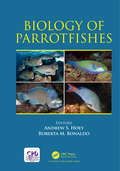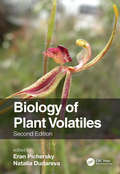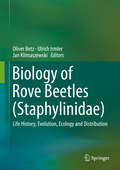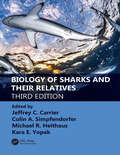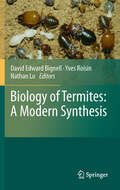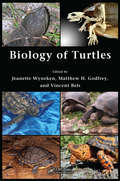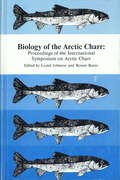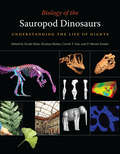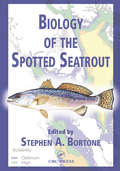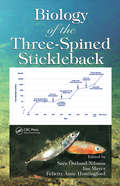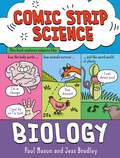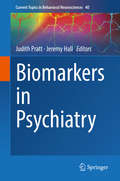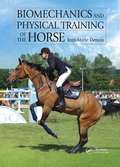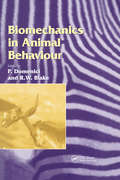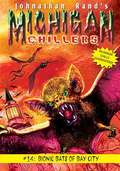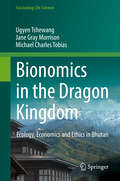- Table View
- List View
Biology of Earthworms (Soil Biology #24)
by Ayten KaracaEarthworms, which belong to the order Oligochaeta, comprise roughly 3,000 species grouped into five families. Earthworms have been called 'ecosystem engineers'; much like human engineers, they change the structure of their environments. Earthworms are very versatile and are found in nearly all terrestrial ecosystems. They play an important role in forest and agricultural ecosystems. This Soil Biology volume describes the various facets of earthworms, such as their role in soil improvement, soil structure, and the biocontrol of soil-borne plant fungal diseases. Reviews discuss earthworms' innate immune system, molecular markers to address various issues of earthworm ecology, earthworm population dynamics, and the influences of organic farming systems and tillage. Further topics include the characteristics of vermicompost, relationships between soil earthworms and enzymes, the role of spermathecae, copulatory behavior, and adjustment of the donated sperm volume.
Biology of Echinodermata
by T. YanagisawaThe proceedings of the Seventh International Echinoderm Conference, held at Atami, Japan, September 1990. In addition to sections covering ecology, evolution, reproduction, morphology, molecular biology, developmental biology, physiology, behavior, and paleontology, there are four plenary lectures a
Biology of Fishes
by Richard Moore Quentin BoneThe VitalBook e-book version of Biology of Fishes is only available only in the US and Canada at the present time. To purchase or rent please visit http://store.vitalsource.com/show/978-1-1341-8631-0. The Third Edition of Biology of Fishes is chiefly about fish as remarkably efficient machines for coping with the many problems that life in wat
Biology of Forensically Important Invertebrates
by Shyamasree Ghosh Dhriti BanerjeeThis book emphasizes the important role of invertebrates in forensic sciences in the detection of crimes, determining the time and place of death, estimating the minimum Post-Mortem Interval (PMI), and determining the cause of death. The initial chapter discusses the forensically essential invertebrates, especially flies under Order Diptera. Further, the book highlights the importance, biology, taxonomy, and biodiversity of flies under Order Diptera with forensic importance. It also discusses the Cuticular HydroCarbons (CHC) and spectrometry-based studies reported from flies and larvae of forensic importance. It further reviews the importance of DNA barcoding in molecular taxonomy-based studies on forensic flies through understanding, identification, and grouping the organisms. Towards the end, this book presents the applications and limitations of forensic entomology in cases of animal cruelty to a veterinary professional.
Biology of Gall Midges: Evolution, Ecology, and Biological Interactions (Entomology Monographs)
by Junichi Yukawa Makoto TokudaThis book provides practical ecological, ethological, evolutionary, and biogeographic data for gall-inducing cecidomyiids, their galls and host plants, based on field surveys, laboratory experiments and genetic analysis. It refers to various researches on gall-inducing insects published by a world of biologists. Practical methods of field surveys and data analysis are presented, as well as topics on parasitoids, invasive pests, and beneficial gall midges that would be useful for applied entomologists. Readers can learn an ecological way of thinking through diverse interrelations between insects and plants, and the analysis of ecological data from gall-inducing cecidomyiids. Galls can be easily observed in the field continuously from early to final stage of the development of galls and gall inducers because of their outstanding features and immobility. It provides important data of the host plant such as phenology, abundance as food resources, and the survival of galled organs. By taking these advantages, many biologists have used galls and gall-inducing insects as highly convenient organisms for a wide range of studies including ecology, ethology, evolution, and biogeography. The book primarily intends to present the appeal of galls and gall-inducing insects for various biological studies. In particular, gall-inducing cecidomyiids are ideal insects to study ecology and evolution. It helps to open the doors to further cryptic study subjects. Also, integrating various ecological, ethological, evolutionary and biogeographic data as shown in this book can serve to further advance the macroevolutionary studies of insects.
Biology of Marine Birds (CRC Marine Biology Series)
by Joanna Burger E. A. SchreiberBiology of Marine Birds provides the only complete summary of information about marine birds ever published. It analyzes their breeding biology, ecology, taxonomy, evolution, fossil history, physiology, energetics, and conservation. The book covers four orders of marine birds in detail and includes two summary chapters that address the biology of shorebirds and wading birds and their lives in the marine environment. Summary tables give detailed information on various aspects of their life histories, breeding biology, physiology and energetics, and demography. It provides a guide to ornithologists and students for research projects.
Biology of Marine Mammals
by John E. ReynoldsTaking an integrated approach to the biology of marine carnivores, cetaceans, and sirenians, twenty-two prominent researchers compare marine mammals with one another and with terrestrial mammals, providing a framework for fundamental biological and ecological concepts. They describe functional morphology, sensory systems, energetics, reproduction, communication and cognition, behavior, distribution, population biology, and feeding ecology. They also detail the physiological adaptations--for such activities and processes as diving, thermo-regulation, osmoregulation, and orientation--that enable marine mammals to exploit their aquatic environment.
Biology of Parrotfishes
by Andrew S. Hoey Roberta M. BonaldoParrotfish are found on almost every coral reef in the world. This ubiquity and uniqueness of their feeding action make them one of the most important groups of fishes within coral reef ecosystems. But why, exactly, are parrotfish so important to reefs? Can the evolution of a particular jaw morphology and feeding action really have had such a large impact on the health and functioning of the world's coral reefs? This book introduces the reader to this fascinating group of fishes (Labridae, Scarinae), from the morphological innovation of a jaw that has the power to bite through solid calcium carbonate, to the threats currently faced by parrotfish populations around the world. It contains new insights into their diet and food processing ability, and lifehistories, and concludes with an overview of emerging and future research directions.
Biology of Plant Volatiles
by Eran Pichersky Natalia DudarevaPlant volatiles—compounds emitted from plant organs to interact with the surrounding environment—play essential roles in attracting pollinators and defending against herbivores and pathogenes, plant-plant signaling, and abiotic stress responses. Biology of Plant Volatiles, with contributions from leading international groups of distinguished scientists in the field, explores the major aspects of plant scent biology. Responding to new developments in the detection of the complex compound structures of volatiles, this book details the composition and biosynthesis of plant volatiles and their mode of emission. It explains the function and significance of volatiles for plants as well as insects and microbes whose interactions with plants are affected by these compounds. The content also explores the biotechnological and commercial potential for the manipulation of plant volatiles. Features: Combines widely scattered literature in a single volume for the first time, covering all important aspects of plant volatiles, from their chemical structures to their biosynthesis to their roles in the interactions of plants with their biotic and abiotic environment Takes an interdisciplinary approach, providing multilevel analysis from chemistry and genes to enzymology, cell biology, organismal biology and ecology Includes up-to-date methodologies in plant scent biology research, from molecular biology and enzymology to functional genomics This book will be a touchstone for future research on the many applications of plant volatiles and is aimed at plant biologists, entomologists, evolutionary biologists and researchers in the horticulture and perfume industries.
Biology of Rove Beetles (Staphylinidae): Life History, Evolution, Ecology And Distribution
by Oliver Betz Ulrich Irmler Jan KlimaszewskiRove beetles (Staphylinidae) are common elements of the soil biota, living in the litter and deeper soil layers. Although they are one of the most diverse and speciose groups of insects, no comprehensive books on their general evolution and ecology are as yet available. This book fills that gap, discussing significant aspects and active research examples in the fields of phylogeny and systematics, ecology and conservation, and reproduction and development. The combination of review chapters and case studies provides an excellent introduction to the biology of rove beetles and enables readers to become familiar with active research fields in this megadiverse group of beetles. Offering easy access to these fields, it also demonstrates how staphylinids are used as bioindicators in applied ecosystem research, including that concerning conservation issues. Experienced scientists and beginners alike find the diversity of subjects covered intriguing and inspiring for continuing and starting their own research. The book is intended for students and researchers in biology and zoology (entomology), including morphologists, ecologists, soil scientists, evolutionary biologists, paleontologists, biogeographers, taxonomists and systematists.
Biology of Sharks and Their Relatives (CRC Marine Biology Series)
by Michael R. Heithaus Colin A. Simpfendorfer Jeffrey C. Carrier Kara E. YopakBiology of Sharks and Their Relatives is an award-winning and groundbreaking exploration of the fundamental elements of the taxonomy, systematics, physiology, and ecology of sharks, skates, rays, and chimera. This edition presents current research as well as traditional models, to provide future researchers with solid historical foundations in shark research as well as presenting current trends from which to develop new frontiers in their own work. Traditional areas of study such as age and growth, reproduction, taxonomy and systematics, sensory biology, and ecology are updated with contemporary research that incorporates emerging techniques including molecular genetics, exploratory techniques in artificial insemination, and the rapidly expanding fields of satellite tracking, remote sensing, accelerometry, and imaging. With two new editors and 90 contributors from the US, UK, South Africa, Portugal, France, Canada, New Zealand, Australia, India, Palau, United Arab Emirates, Micronesia, Sweden, Argentina, Indonesia, Cameroon, and the Netherlands, this third edition is the most global and comprehensive yet. It adds six new chapters representing extensive studies of health, stress, disease and pathology, and social structure, and continues to explore elasmobranch ecological roles and interactions with their habitats. The book concludes with a comprehensive review of conservation policies, management, and strategies, as well as consideration of the potential effects of impending climate change. Presenting cohesive and integrated coverage of key topics and discussing technological advances used in modern shark research, this revised edition offers a well-rounded picture for students and researchers.
Biology of Termites: A Modern Synthesis
by David Edward Bignell Yves Roisin Nathan LoBiology of Termites, a Modern Synthesis brings together the major advances in termite biology, phylogenetics, social evolution and biogeography. In this new volume, David Bignell, Yves Roisin and Nathan Lo have brought together leading experts on termite taxonomy, behaviour, genetics, caste differentiation, physiology, microbiology, mound architecture, biogeography and control. Very strong evolutionary and developmental themes run through the individual chapters, fed by new data streams from molecular sequencing, and for the first time it is possible to compare the social organisation of termites with that of the social Hymenoptera, focusing on caste determination, population genetics, cooperative behaviour, nest hygiene and symbioses with microorganisms. New chapters have been added on termite pheromones, termites as pests of agriculture and on destructive invasive species.
Biology of Turtles: From Structures to Strategies of Life
by Vincent Bels Jeanette Wyneken Matthew H. GodfreyFeaturing in-depth contributions from an international team of experts, the Biology of Turtles provides the first comprehensive review of the Testudinata. The book starts with the premise that the structure of turtles is particularly interesting and best understood within the context of their development, novelty, functional diversity, and e
Biology of the Arctic Charr: Proceedings of the International Symposium on Arctic Charr
by Lionel Johnson Bonnie BurnsProceedings of the International Symposium on Arctic charr held in Winnipeg, 4-8 May 1981, on the campus of the University of Manitoba.
Biology of the Invertebrates
by Jan PechenikThis textbook is the most concise and readable invertebrates book in terms of detail and pedagogy (other texts do not offer boxed readings, a second color, end of chapter questions, or pronunciation guides). All phyla of invertebrates are covered (comprehensive) with an emphasis on unifying characteristics of each group.
Biology of the Sauropod Dinosaurs: Understanding the Life of Giants (Life of the Past)
by Nicole Klein, Kristian Remes, Carole T. Gee and P. Martin SanderSauropods, those huge plant-eating dinosaurs, possessed bodies that seem to defy every natural law. What were these creatures like as living animals and how could they reach such uniquely gigantic sizes? A dedicated group of researchers in Germany in disciplines ranging from engineering and materials science to animal nutrition and paleontology went in search of the answers to these questions. Biology of the Sauropod Dinosaurs reports on the latest results from this seemingly disparate group of research fields and integrates them into a coherent theory regarding sauropod gigantism. Covering nutrition, physiology, growth, and skeletal structure and body plans, this volume presents the most up-to-date knowledge about the biology of these enormous dinosaurs.
Biology of the Spotted Seatrout (CRC Marine Biology Series)
by Stephen A. BortoneThe spotted seatrout is an important species not only for recreational and commercial fisheries, but also as an integral part of many estuarine ecosystems. As one of the few fishes that live its entire life within an estuarine system, the species has tremendous potential as a monitor or sentinel for estuarine conditions. Prepared by the foremost au
Biology of the Three-Spined Stickleback (CRC Marine Biology Series)
by Sara Östlund-Nilsson Ian Mayer Felicity Anne HuntingfordHighlighting the growing importance of the sticklebacks as a model species in emerging fields such as molecular genetics, genomics, and environmental toxicology, Biology of the Three-Spined Stickleback examines data from researchers who use studies of the stickleback to address a wide range of biological issues. This state-of-the-art volume
Biology: The science of animals, plants and the human body (Comic Strip Science #1)
by Paul MasonComic Strip Biology makes learning about the science behind animals, plants and the human body fun! Each spread in this series features a short, funny comic strip that explains a process or aspect of science. Around the comic strip, diagrams and panels give further information on the topic. They are a fantastic way to engage children aged 8 plus with science.The illustrator, Jess Bradey, is winner of the 2021 Blue Peter Award for Best Non-Fiction for A Day in the Life of a Poo, Gnu and You and also writes and draws for The Phoenix Comic. Titles in the series: Biology, Chemistry, Earth and Space, Physics.
Biomarkers in Psychiatry (Current Topics in Behavioral Neurosciences #40)
by Judith Pratt Jeremy HallThis volume addresses one of the Holy Grails in Psychiatry, namely the evidence for and potential to adopt ‘Biomarkers’ for prevention, diagnosis, and treatment responses in mental health conditions. It meshes together state of the art research from international renowned pre-clinical and clinical scientists to illustrate how the fields of anxiety disorders, depression, psychotic disorders, and autism spectrum disorder have advanced in recent years.
Biomechanics and Physical Training of the Horse
by Jean-Marie DenoixEffective horse trainers strive to improve the performance of their horses while preserving the integrity of the musculoskeletal apparatus. Biomechanics and Physical Training of the Horse supplies an anatomical and functional overview of the topic, enabling trainers to optimize the different exercises their horses undergo during training and compet
Biomechanics in Animal Behaviour
by P. DOMENICI; R.W. BLAKEBiomechanics in Animal Behaviour offers a unique approach by integrating fully the fields of animal behaviour and biomechanics. It demonstrates how an understanding of biomechanical issues is an important part of evaluating and predicting animal behaviour. The book examines how behaviour is determined and/or constrained by biomechanical variables such as hydrodynamics, aerodynamics, kinematics, and the mechanical properties of biomaterials.
Bionic Bats of Bay City (Michigan Chillers #14)
by Johnathan RandMICHIGAN CHILLERS WINGED MONSTERS ATTACK AN ENTIRE CITY! On a dark night in Bay City, Michigan, friends gather to plan an innocent game of hide-and-seek. However, just as they begin to play, one of them sees a bat. But it's not any ordinary bat. In fact, the bat is gigantic--as big as some of the children! And there's more than one. Forced to abandon their game, five children must flee the vicious attacks of these giant creatures from the sky. Unable to take refuge in their homes, they must fight to survive. Where did these bats come from? How on earth did they grow to such enormous size? And most important: will the five children be able to defend themselves until help arrives, or will the bats have their way? It's a night of horror in Bay City . . . and for five friends, it just might be their last night alive! #14: Bionic Bats of Bay City by Johnathan Rand
Bionomics in the Dragon Kingdom: Ecology, Economics and Ethics in Bhutan (Fascinating Life Sciences)
by Michael Charles Tobias Jane Gray Morrison Ugyen TshewangThis compact and elegant work (equally fitting for both academic as well as the trade audiences) provides a readily accessible and highly readable overview of Bhutan’s unique opportunities and challenges; all her prominent environmental legislation, regulatory statutes, ecological customs and practices, both in historic and contemporary terms. At the same time, Bionomics places the ecological context, including a section on animal rights in Bhutan, within the nation’s Buddhist spiritual and ethical setting. Historic contextualization accents the book’s rich accounting of every national park and scientific reserve, as well as providing up-to-the-minute climate-change related hurdles for the country.Merging the interdisciplinary sciences, engineering and humanities data in a compelling up-to-date portrait of the country, the authors have presented this dramatic compendium against the backdrop of an urgent, global ecological time-frame. It thus becomes clear that the articulated stakes for Bhutan, like her neighboring Himalayan and Indian sub-continental countries (China, India, Bangladesh and Myanmar) are immense, as the Anthropocene epoch unfolds, affecting every living being across the planet. Because Bhutan’s two most rewarding revenue streams derive from the sale of hydro-electric power and from tourism, the complexities of modern pressures facing a nation that prides herself on maintaining traditional customs in what has been a uniquely isolated nation are acute.

